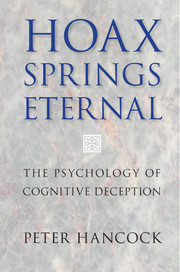Case 5 - Piltdown Man
The Desire That the First Human Being Be an Englishman
Published online by Cambridge University Press: 05 January 2015
Summary
Introduction
An account of Piltdown Man is unlike any of the other stories of cognitive deception discussed in this book. This is because we now know categorically that the Piltdown remains are, in fact, a hoax. Therefore, we naturally approach this story with a strong propensity toward a level of hindsight bias that encourages us to be wise after the event [1]. Our first thought, therefore, should be to appreciate that many of the individuals involved with the Piltdown finds were as certain of its authenticity in their time as we are now of its fraudulence. The real story of the Piltdown hoax, however, does not begin with the findings of the bones themselves. Rather, it is framed by the context of the times and especially the continuing aftershocks of Charles Darwin’s pivotal proposition concerning the evolution of life on our planet [2]. If what Darwin had said concerning evolution were true, then the theory predicted that there ought to be recognizable fossils of the ancestors of modern human beings connecting us to our nonhuman forebears. For a number of decades, the race was on to find the definitive evidence of this “missing link.”
To the great chagrin of the British scientific community, intriguing evidence of earlier hominids had been found in Belgium as well as in both Germany and France, the great European rivals of the British Empire [3]. However, after the turn of the century, with the Edwardian era replacing the venerable Victorian age, no such prestigious fossils had been found in “England’s green and pleasant land.” That Britain may not have actually been an island at the time that some of these European ancestors existed mattered not one whit to the members of the British establishment; the implied insult persisted. The geopolitical rivals had their “early man” while England did not. The French even had a derogatory term for their English colleagues; they called them “pebble hunters.” It was in this receptive and fertile soil of fervent British patriotism that the Piltdown remains, produced by the amateur scientist Charles Dawson, so quickly took root. His discoveries were evidently a manifest “rival to the German’s Ape Man.” Eventually, the Piltdown fossils were to become much more than this and ended up being, arguably, the most explosive case of scientific fraud that has ever been uncovered [4].
- Type
- Chapter
- Information
- Hoax Springs EternalThe Psychology of Cognitive Deception, pp. 132 - 153Publisher: Cambridge University PressPrint publication year: 2015



